25-Hydroxyvitamin D2/D3 Analysis in Human Plasma Using LC–MS
Special Issues
Increases in vitamin D testing frequency have required more rapid and cost-effective solutions for determining vitamin D levels in plasma. This LC–MS method was adapted for use with core-shell columns to achieve run times of less than 4 min.
One of the biggest debates in clinical medicine currently revolves around understanding the proper levels of vitamin D in patients' plasma. Besides well-known diseases like rickets and osteomalacia, vitamin D deficiency has been linked to cancer and heart disease and is rapidly becoming the most widely used liquid chromatography–mass spectrometry (LC–MS)–based clinical test. Increases in testing frequency have required more rapid and cost-effective solutions for determining vitamin D levels in plasma. An LC–MS method for vitamin D2/D3 was adapted for use with core-shell columns to achieve run times of less than 4 min. This method provides rapid, sensitive, rugged, and robust LC–MS-MS analysis of vitamin D levels in patient serum (LOD of 1 and 2 ng/mL for 25-OH D3 and 25-OH D2, respectively, with CV of 4–7%) and speeds the diagnosis by hospital and clinical laboratories of potential vitamin D deficiencies.
Vitamin D is recognized as an essential nutrient with its primary physiological function being to increase intestinal absorption of calcium and phosphate and to promote deposition of these minerals in newly formed bones. Deficiency and abnormal vitamin D levels result in impaired bone mineralization and lead to bone softening diseases — rickets in children and osteomalacia in adults. In addition, a large number of bone disorders and mineral metabolism defects have been associated with abnormal vitamin D levels, including nephritic syndrome, granulomatous diseases, and hypocalcemia, as well as secondary hyperparathyroidism, which frequently complicates renal failure. Additional well-known maladies, including cardiovascular disease, cancer, and autoimmune disorders, recently have been found to be influenced by vitamin D deficiencies; as a result, vitamin D testing has increased tremendously across a variety of patient groups (1,2).
Vitamin D is metabolized to 25-OH D in the liver. Total vitamin D is best determined by measuring total 25-hydroxyvitamin D (D2 and D3) in serum because the half-life of 25-OH D is about three weeks with serum concentrations of 10–50 ng/mL. Vitamin D supplementation in both food and tablets comes in both the D2 and D3 forms, making it imperative to measure 25-OH D2 and 25-OH D3. Although optimal serum concentrations of total 25-OH D are generally agreed to be ≥30 ng/mL, there is considerable discussion on the serum concentration of 25-OH D considered to be inadequate for bone and overall health, but <20 ng/mL is generally regarded as deficient. Serum concentrations >100 ng/mL are generally regarded as potentially toxic (3).
Vitamin D exhibits a high propensity for inherent endogenous serum protein binding and association. Vitamin D is typically not found free in serum samples, thereby posing a challenge for sensitive and reproducible high performance liquid chromatography (HPLC) analysis without appropriate sample preparation. Additionally, various serum sample matrix constituents are found to cause ion suppression that reduces accuracy and reproducibility during patient sample analysis. This ion suppression can be especially troublesome with rapid LC–mass spectrometry (MS) methods where insufficient resolution can be observed between matrix contaminants and analyte peaks.
A recent innovation in HPLC column technology has been the introduction of core-shell silica particles. Unlike fully porous silica media, core-shell media employ structured particle geometry where a thin porous shell is grafted on a nonporous core particle. This particle geometry has a reduced analyte diffusion distance along with a tight particle size distribution that results in column efficiency on par with or better than sub-2-µm media while maintaining column back pressures more in line with traditional HPLC columns. Higher performance at lower back pressure using core-shell HPLC columns offers the promise of improving existing HPLC methods without having to replace existing HPLC instrumentation with ultrahigh-pressure-compatible LC systems. This article discusses an example of using core-shell columns to improve the resolution of a separation while reducing analysis run time.
Experimental
Reagents and Chemicals
25-Hydroxyvitamin D3 and 25-hydroxyvitamin D3-d6 were obtained from Medical Isotopes (Pelham, New Hampshire) and 25-hydroxyvitamin D2 was obtained from Sigma-Aldrich (St. Louis, Missouri). HPLC-grade water (Milli-Q, Millipore, Billerica, Massachusetts) was used to prepare HPLC mobile phase and for sample preparation. Methanol and acetonitrile were obtained from Honeywell, Burdick & Jackson (Muskegon, Michigan). Stock internal standard solution was prepared by dissolving the contents of a 5-mg vial of 25-hydroxyvitamin D3-d6 in 5.0 mL of ethanol. The precipitation reagent was prepared by adding 10 µL of internal standard stock solution to 60 mL of 95:5 (v/v) acetonitrile–methanol in a 100-mL volumetric flask and diluting to volume with 95:5 acetonitrile–methanol. To analyze patient samples, 350 µL of precipitating reagent containing internal standard was combined with 100 µL of serum and vortexed for 30 s. After inspecting the tube to ensure that the sample was fully mixed, the sample was centrifuged at 13,000 rpm for 15 min. Supernatant was transferred to an HPLC vial and 40 µL was injected onto an LC–MS-MS system.
LC–MS-MS was performed using an HPLC system equipped with binary pump, autosampler, and column oven interfaced with an Applied Biosystems 4000 Qtrap mass spectrometer (AB Sciex, Foster City, California) with a Turbo V ion source or with an Applied Biosystems API 4000 triple-quadrupole mass spectrometer. An atmospheric pressure chemical ionization (APCI) source was used and was run in positive ion mode. The MS-MS operating conditions are listed in Table I. The HPLC column used for all analyses was a 50 mm × 4.6 mm, 2.6-µm core-shell Kinetex C18 column (Phenomenex, Torrance, California) operating at a flow rate of 1 mL/min. This method was compared against a methodology using a fully porous 5-µm C18 column. A gradient method was employed using an aqueous mobile phase A of 0.05% formic acid in water and an organic mobile phase B of 0.1% formic acid in methanol with 5 mM ammonium acetate. The gradient was as follows: hold at 8% B for 5 s, then 8–100% B in 200 s (3.33 min). The column was washed and re-equilibrated between injections and maintained at 35 °C.
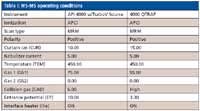
Table I: MS-MS operating conditions
Results and Discussion
Analysis of 25-OH D2 and 25-OH D3 from serum necessitates the use of sample preparation procedures to remove potential matrix constituents, which will interfere with accurate and precise determination of 25-OH D in serum and reduce HPLC column life. Vitamin D and the hydroxy D metabolites are relatively more hydrophobic than virtually all endogenous and exogenous compounds that are typically quantified in biological matrices. The propensity for vitamin D to inherently associate with serum proteins reduces the bioavailability of free vitamin D in serum; therefore, it is necessary to disrupt this association for improved assay accuracy and precision. Protein precipitation is the easiest means of disrupting the serum protein association with hydrophobic analytes. In this method, protein precipitation is performed in 1.5-mL centrifuge tubes with the addition of 100 µL of serum sample to 350 µL of 95:5 acetonitrile–methanol containing the 25-OH D3-d6 internal standard. The low solubility of the endogenous proteins in acetonitrile results in their precipitation from the sample; mixing and centrifugation cause the precipitated protein to form a pellet at the bottom of the centrifuge tube, and the supernatant is then analyzed. An alternative to the traditional protein precipitation approach involves the use of a protein precipitation plate, such as Strata Impact (Phenomenex), which contains an oleophobic membrane filter. Following addition of acetonitrile to the serum sample to facilitate protein precipitation, the sample passes through a 0.2-µm cut-off filter of the precipitation plate to eliminate the precipitated protein from the sample.

Table II: API 4000 triple-quadrupole MS system
LC–MS was performed in multiple reaction monitoring (MRM) mode (see Tables II and III for the MRM transitions monitored using the API 4000 and QTRAP MS systems, respectively). The use of MRM is important because 25-OH D2 and 25-OH D3 are not separated chromatographically; however, the unique parent–daughter ion combination for each analyte allows for specificity and accurate determination of the concentration for each analyte in the sample. 25-OH D3-d6 was used as an internal standard and signal intensity of each 25-OH D analyte relative to the internal standard was used for determining the concentration of 25-OH D2 and 25-OH D3 in the sample. The calibration curves were linear over the range from 0 to >500 ng/mL, with observed limits of detection (LOD) of 1 and 2 ng/mL for 25-OH D3 and 25-OH D2, respectively. The reproducibility of this assay was very good with CV of 4–7%.

Table III: 4000 QTrap MS system
Both the HPLC and UHPLC conditions using a 50 mm × 2.0 mm, 5-µm fully porous C18 column and the 2.6-µm core-shell column, respectively, allow for sufficient retention of 25-OH D2 and 25-OH D3, further minimizing the potential for interference and ion-suppression from any weakly retained impurities (Figures 1 and 2). Using the 5-µm C18 column, elution of 25-OH D2 and 25-OH D3 occurred in just under 5 min, with an overall chromatographic run time of 8 min, including column re-equilibration. The separation using the 2.6-µm core-shell C18 column is similar; however, 25-OH D2 and 25-OH D3 are eluted in less than 4 min. This allows the overall chromatographic run time, including column re-equilibration, to be reduced to 6 min. The shorter analysis time using the core-shell column is a significant benefit for laboratories analyzing a large number of samples in a high-throughput sample environment — the reduction in overall chromatographic run time translates into a 25% increase in sample throughput and corresponding reduction in solvent usage. In addition to the faster chromatographic separation, the peak intensities are significantly larger on the core-shell column resulting in improved sensitivity and lower quantitation limits.
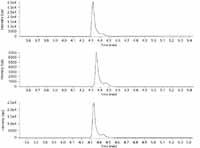
Figure 1: LCâMS-MS analysis of 25-OH D2 and D3 standards run on a fully porous 5-µm C18 column. Note the similar elution time for 25-OH D2, 25-OH D3-d6 internal standard, and the 25-OH D3 peaks.
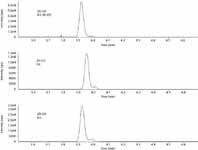
Figure 2: UHPLCâMS-MS analysis of 25-OH D2 and D3 standards run on a Kinetex 2.6-µm C18 column. Note the reduced retention time, improved peak shape, and increased peak height for the standards run on the Kinetex core-shell column.
The most important benefit is the improved efficiency and resolution provided by the core-shell column. With the fully porous 5 µm C18 column, an endogenous compound (D3 cholesterol) present in patient samples was found to be coeluted with the 25-OH D3 peak, impacting accurate quantitation and increasing the need to reanalyze a large percentage of patient samples (Figure 3). The presence of the endogenous compound in patient samples was resolved from 25-OH D3 and was eluted outside the quantitation window on the core-shell column (Figure 4), resulting in increased analytical accuracy. This improvement in throughput and resolution was achieved at system back pressures compatible with standard HPLC systems (400-bar back-pressure limit).
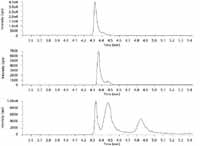
Figure 3: LCâMS-MS analysis of 25-OH D2 and D3 standards spiked into plasma run on the fully porous 5-µm C18 column after protein precipitation. Note the interfering D3 cholesterol peak that is eluted just after the 25-OH D3 peak. This interference can greatly perturb the quantitation of the D3 peak.
Conclusions
The analytical method presented above allows for the rapid and accurate determination of vitamin D levels in patient serum samples and speeds the diagnosis of potential vitamin D deficiencies indicative of specific disease states quickly and with a high degree of precision. Protein precipitation is used for sample preparation of patient serum samples, effectively disrupting the serum protein association with 25-OH D2 and 25-OH D3 and providing sufficient sample cleanup before LC–MS-MS analysis. Protein precipitation plates would be an effective alternative for sample preparation in a high-throughput clinical laboratory environment.
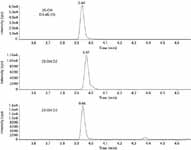
Figure 4: LCâMS-MS analysis of 25-OH D2 and D3 standards spiked into plasma run on the core-shell Kinetex 2.6-µm C18 column after protein precipitation. Note that the interfering peak in Figure 3 with the fully porous column is not eluted near the 25-OH D3 peak, thus peak quantitation is not affected when the core-shell column is used for this application.
The core-shell column allows for faster chromatographic analysis of patient samples and increased signal intensity for improved sensitivity. The increase in chromatographic resolution from an endogenous compound present in patient serum samples provides improved accuracy and reproducibility and a decrease in sample reanalysis. This clinical example shows the advantages of using core-shell columns with existing HPLC instrumentation to realize an improvement in throughput and performance. Other UHPLC columns require ultrahigh-pressure instrumentation, which can be a difficult (and unnecessary) choice in the current economic climate.
Phil Koerner and Michael McGinley are with Phenomenex, Torrance, California.
References
(1) Dietary Supplement Fact Sheet: Vitamin D; Office of Dietary Supplements, National Institutes of Health (http://ods.od.nih.gov/factsheets/vitamind.asp).
(2) M.F. Holick, American Journal of Clinical Nutrition 80(6), 1678–1688 (2004).
(3) Institute of Medicine, Food and Nutrition Board. Dietary Reference Intakes: Calcium, Phosphorus, Magnesium, Vitamin D, and Fluoride. Washington, DC: National Academy Press, 1997.
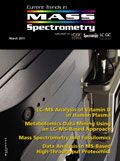
Evaluating Body Odor Sampling Phases Prior to Analysis
April 23rd 2025Researchers leveraged the advantages of thermodesorption, followed by comprehensive two-dimensional gas chromatography coupled to time-of-flight mass spectrometry (GC×GC/TOF-MS), to compare and assess a variety of sampling phases for body odor.

.png&w=3840&q=75)

.png&w=3840&q=75)



.png&w=3840&q=75)



.png&w=3840&q=75)










